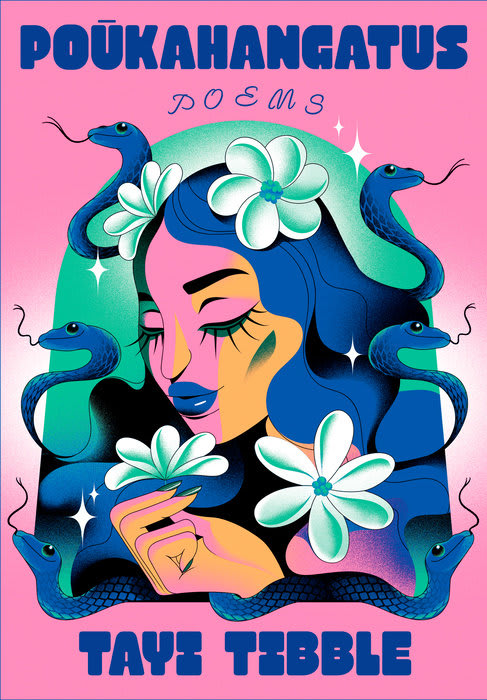
Another accolade for NZ's most internationally recognised poet
Wellington poet Tayi Tibble has become only the fourth* New Zealand author - and first Māori writer - to have work published in the New Yorker magazine.
Her poem "Creation Story" appears in the latest issue, which went online at 10pm on Monday night. It hogs most of a double-page spread - it's quite long, with classic Tibble lines ("I'm like wtf was I even thinking") and the startling, 100 percent Aotearoa presence of te reo (she references Ruaumoko, Mahuika, Hineahuone) in the most prestigious journal in American letters.
To herald the publication of a poem in an overseas magazine is adjacent to cultural cringe, to parish pump reporting, but it's cultural cringe and parish pump with good precedent: Stuff ran a celebratory yarn the last time a New Zealand author had their work accepted in the magazine, in 2009, when Bill Manhire's poem "My Childhood in Ireland" was published ("With characteristic humility, he said it was 'very nice'", Stuff reported). It was claimed at the time that Manhire was the third New Zealander* to be published in the New Yorker, after Janet Frame (two short stories were published, in 1962 and 1969) and CK Stead, in 2008, with a poem about Katherine Mansfield.
Frame, Stead, Manhire...and now Tibble, in this select pantheon* of New Zealand writers. It's the latest accolade for a writer who has become international property. She went to high school at Aotea College in Porirua, and graduated with an MA in creative writing at the dear old IIML, where she won the Adam Foundation Prize (previous winners include Eleanor Catton and Ashleigh Young). Te Herenga Waka University Press published her two collections of poetry, Poūkahangatus and Rangikura, in 2018 and 2021, respectively. They were both finalists for the poetry prize at the Ockhams, and she found time to win best personal essay at the 2020 Voyager Media Awards for her epic reportage "Ihumātao: Everyone was there, e hoa".
And then the world came calling. Knopf in the US and Penguin in the UK published her two books (the international cover of Poūkahangatus is at the end of the story), which has led to a frankly awesome 12 months of appearing at festivals and events in New York, Los Angeles, San Francisco, Seattle, Paris, London, and, most recently, at Lillehammer in Norway.
Norway! At 27, she has already achieved more international recognition than many New Zealand writers plugging away over a long and dutiful career. An email interview was conducted to mark the occasion of her publication in the New Yorker.
*
Did you submit the poem to the New Yorker, or your American publisher John Freeman?
I submitted it after encouragement from John. I met the poetry coordinator Hannah at a gathering John threw for me in his apartment in New York. We chatted, she was really nice and she expressed interest in reading new work if had some and I got her contact. I met Kevin, the magazine's poetry editor, in Paris last summer too, when we both taught at the NYU summer school program.
Where did you write the poem - at home, or on your travels around the world?
I honestly don’t remember — but I remembered when I had a proper go at it, it poured out, one of those poems that arrived nearly in its entirety.
Whereabouts do you generally write?
I write in my bedroom at night mostly, but I also write anywhere and everywhere, I’m always writing freakish little notes on my phone.
Have you written many poems since Rangikura?
I’ve written a handful of poems, but I’ve been writing a lot of non-fiction, hybrid essays, bits of memoir etc. It's all been very oceanic and pacific though, that's my current vibe.
You travelled a lot last year and appeared at festivals with other indigenous writers. Was this an influence on your "Creation Story" poem?
Not directly, but I do think more about being in conversation with a wider network of indigenous peoples now. I know that our stories speak to each other, and awhi each other. I like the American style of poetry though, that is a bit more disparate and flowery than our style, which I’d say is more plainspoken and direct. But the poem is about partying with creative native people lol, and feeling like oh wow your existence is so amazing against a backdrop of colonisation, and my native American and Canadian mates are definitely at the party turning up too. Can you describe the native American reservation you went to?
I met Sasha La Pointe on my West Coast tour of the US last October/November. We share an agent, and we had readings together in Seattle, Port Townsend and Portland. After our tour, Sasha invited me to come stay with her in her whare on the Pullayup reservation in Tacoma, Washington. It was pretty buzzy. It's a real gritty, diesel, terracotta coloured kind of town. Big Casino, drive through vape store called The War Pony. Dogs howling, raccoons running around. It was nice.
We got real close, stayed up talking late every night in the spa, took walks in the forest, ate salmon cooked in skunk cabbage leaves. Sasha took me to visit her Uncle Muck who is a carver — he was carving paddles and preparing for canoe journey. We went to the premiere of a film called The Salmon People about the mahi her people are doing to bring salmon back into their rivers. We went to Evergreen University, where Sasha teaches and saw the half coast salish, half Māori whare Paimarire. Sasha’s boss Dawn even picked me up one day and took me to lunch with a bunch of Māori visiting from Awanuiarangi Wananga in Whakatāne — it was so crack up. Whaea Waitangi made me recite a poem in front of everyone and then she tautoko’d with a waiata and I was like yup just like back home lol.
It was a really meaningful experience and connection for me, and it really changed my perspective on publishing internationally, it made me feel like I belong somewhere far from where I’m from. I mad appreciate the manaakitanga they showed me.
Do you read the New Yorker?
What kind of question is this? Back to back? Probably not. But otherwise yes I read their articles and poems online often.
What would you like to say about the poem in the New Yorker?
I’m just happy they selected this poem because it’s pretty buzzy, long tbh and I’m proud of it. I think it's a full representation of my Māoritanga, perspective and artistic kaupapa.
* Update: Dunedin writer Philip Temple has written to Newsroom to point out that a fifth New Zealand author has been published in the New Yorker - Maurice Shadbolt, with a short story published in 1959. Frame, Stead, Manhire, Tibble....and now Shadbolt, in this select pantheon.






